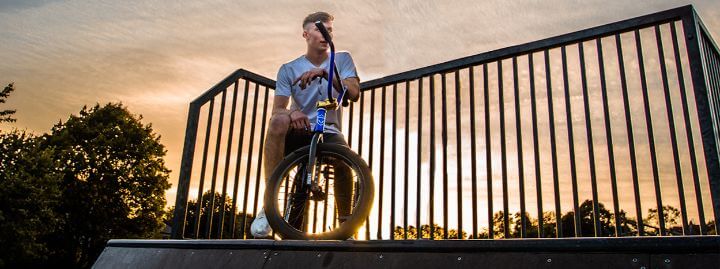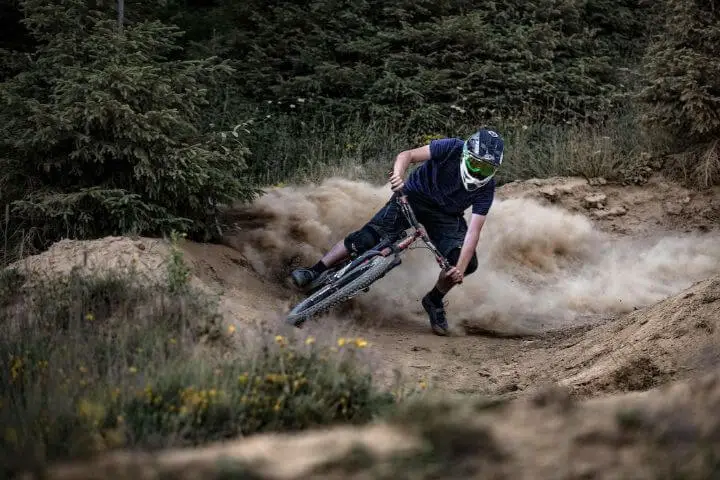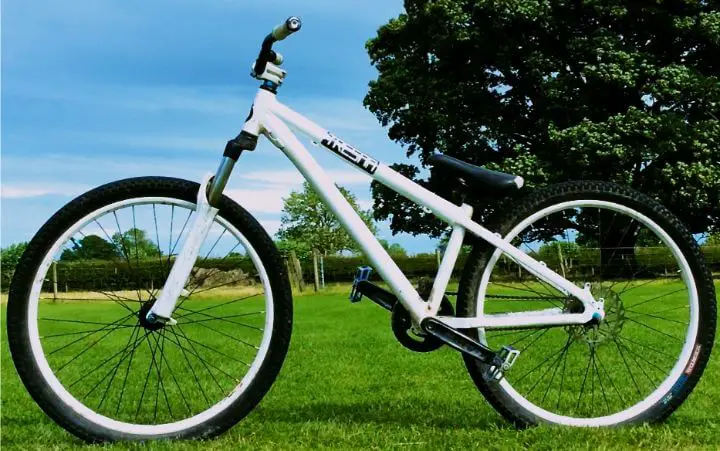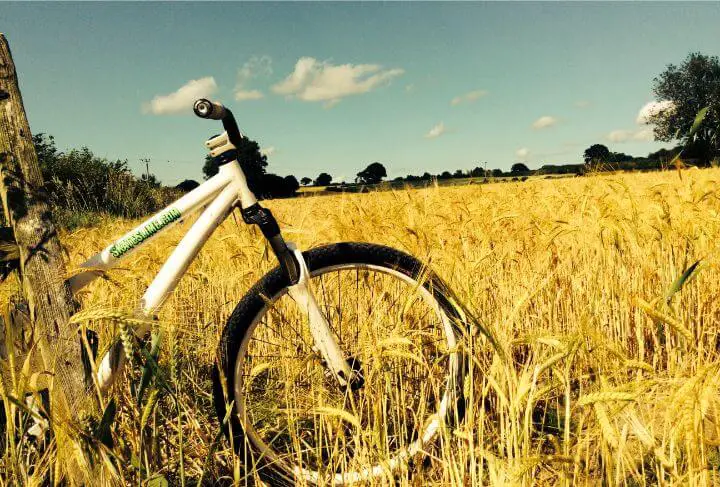Dirt jumping and BMX biking are weirdly similar but also very different. Dirt jumping is a subset of riding with its roots firmly planted in mountain biking. BMX is its own thing entirely. In the early 1970s, certain motocross riders in southern California found a simple and cheap way to get the thrill and enjoyment they crave somewhere other than a motorbike track.
As both cycling disciplines have evolved they’ve become more and more similar. Dirt jump bikes have become streamlined, with a low seat and low stance. Their frames are light and the suspension is comforting but strong.
On the other hand, some BMX riders have started riding the same dirt jumps with their slightly modified BMX bikes. The inherently simple design of a BMX makes it hard to modify the bike for different types of riding. Dirt jump BMX bikes have geometry more similar to a mountain bike. The head tube angle is steeper to prevent the bike from being too twitchy while the top tube length is also commonly longer so the bike will feel more stable at higher speeds.
Other modifications like thicker tires, longer fork arms and sometimes metal pedals help with the dirt build-up when riding wet courses.
History of DJ and BMX Biking

As I mentioned above, bicycle motocross (BMX) originated in southern California as early as 1970. The first BMX events were races and provided a good stepping stone for kids that wanted to get into motocross but were too young or couldn’t afford it.
It was also a great alternative for adults that were interested in motorbikes but didn’t have the money or facilities to consistently ride motorbikes.
BMXing made its way over to the UK and quickly gained popularity in the early 80s. After this popularity increase, more and more manufacturers got on board with a relatively basic and robust design.
The default design with high bars, 20” wheels, single cassette gearing and one or no brakes quickly became the norm. Ever since then, only small changes have been made to these bikes. Improvements are normally performed on the material of the parts and strength of a certain area.
Dirt Jumping is a form of mountain biking. Slopestyle is another discipline very closely related to DJ. There are many different styles of mountain biking that allow all people to ride in so many different situations, dirt jumping and slopestyle is just one of them.
Going back to the very basics, dirt jumping is the practice of riding slimmed-down mountain bikes over shaped mounds of dirt or soil in the hopes of becoming airborne and then performing tricks. Dirt jump bikes take a lot of inspiration from mountain bikes and BMX bikes. From MTB they get the 24” or 26” wheels, suspension and disk brakes. Mountain bikes aren’t always developed for airborne riding so that’s where aspects of BMX are brought in.
BMX’s have fewer components that are much simpler, with less tiny pieces susceptible to easy breakage. Lower seats, shorter fork travel, a lower rear triangle and dirt jump geometry are all taken from BMX to make jump bikes easier to use.
Riding Discipline Differences

![]() Photo by /u/gabrielastin
Photo by /u/gabrielastin
As I’ve mentioned several times now, there are many differences between BMX bikes and DJ/Slopestyle bikes. The riding style is also quite different. In this section, I hope to explain the differences between the two types of bikes, the style of riding you can do on each and finally what I suggest for different people.
Disk Brakes vs U-Brakes
Brakes are used very differently for these two types of bikes. For BMX bikes, brakes are often seen as very unnecessary. This view is taken by different riders for different reasons. A lot of times it’s because of the need to do barspins and tailwhips multiple times takes precedence over being able to stop easily. This may sound stupid but when riding at a skatepark there are a lot of ways to deal with speed, the easiest of which is a quarter pipe.
It’s important to learn to air a quarter or half pipe at speed when getting into BMX. Whether you have brakes or not, you can’t always use them fast enough for them to be effective.
On the other hand, mountain and dirt jump bikes nearly always have at least one brake, usually disk brakes. Apart from some race bikes, all BMXs have U or V brakes that apply friction to the bike’s rims through rubber brake pads.
Disk brakes are either hydraulic or mechanical. They use callipers that squeeze a pair of pads against a metal rotor between 140mm to 210mm wide bolted to the hubs in the centre of the wheel.
Hydraulic brakes are far better than mechanical. The force you apply to the lever is tripled when it’s transferred and applied to the rotor. Malcolm Loughhead invented the hydraulic brake way back in 1914 for his race cars. After receiving a patent in 1917, Malcolm kept evolving the design before it was finally used in commercially available passenger cars in 1921. After many years of being used in the automotive world, hydraulic brakes were finally used on bicycles.
If you’re riding dirt jumps I would always suggest riding with at least one brake; a high-quality U brake for a BMX and a disk brake for dirt jump bikes. Hydraulic brakes aren’t essential but are much better. The advantages you get from mechanical disk brakes are cost, ease of use and ease of maintenance.
Rigid Forks & Bike Suspension
The frame and forks are probably the two parts that have the biggest impact on the riding style of a specific type of bike. In the case of BMXs and dirt jump bikes, the forks couldn’t be more different.
There are two styles of bike forks, suspension or rigid. There’s no special explanation for either of these. Either your bike has suspension which means the forks compress when pressed down or they’re made from one piece of metal and they don’t compress.
Mountain bikes can have rigid forks but it’s quite uncommon. Rigid jump bikes are normally only ridden at skateparks when someone is trying to stay away from riding a BMX bike but still wants to ride at the skatepark.
Most dirt jump forks have around 100mm of travel. This means the forks can be compressed up to a maximum of 100mm safely.
BMX bikes can’t be fitted with suspension. They are completely rigid bikes, which proves to be very uncomfortable when riding on uneven surfaces but it keeps the weight down and you simply don’t need suspension on a skatepark.
Bike Gearing
I nearly didn’t include gears on this list. I hope everyone reading this already knows BMX bikes don’t have gears. On the other end of the spectrum, a lot of mountain bikes have gears. It’d be almost impossible to ride a lot of trails with a single-speed bike.
Whether to run gears on a dirt jump bike is simply a personal preference. Types of frames, hubs and wheels may only work with single speed set-ups but nothing is stopping you from sourcing the correct parts and making your bike multi-geared.
Riding without gears is much more common in dirt jumping. Strength and reliability are the main reasons for this. Riding big jumps on hard dirt causes a fair amount of force to go through the bike, from personal experience I can tell you that a lot of these jumps can rattle the chain straight off the gears. This can be dangerous, so many people simply don’t take the risk and go for a single speed.
Having said this, there are advantages to gears with certain environments and riding styles where it’s preferable. To decide whether gears are a good idea for your bike you must think about all the riding you expect to take part in. 4 cross or mountain cross is a biking style that is very similar to dirt jumping and BMX racing. Four racers race around a BMX style race track to complete the technical dirt track faster than all the other riders.
Mountain cross bikes are effectively dirt jump bikes but with gears. The tracks are generally not a straightforward downhill like slopestyle course. Gearing is much tighter with only a few gears for this style of riding. Having fewer gears means the chain doesn’t have to belong and so can be quite tight, making your bike much more reliable.
20″ vs 26″ Bike Wheels
The wheel size is one of the main differences between BMX and dirt jump bikes. The wheels on DJ and Slopestyle bikes go from 24” to 26”. While it’s possible to have a 27.5” or 29” wheelset on a jump bike it’s quite uncommon.
BMX bikes, on the other hand, are nearly always 20”. The only difference comes with younger riders that might ride something like an 18” bike.
There are advantages and disadvantages to both wheel sizes. Smaller wheels have better acceleration and tight cornering ability but you won’t get anywhere near the top speed of a 29” wheel on a BMX.
Larger wheels have more rotational inertia since most of its weight is farther from the hub. You will gain speed slower with larger wheels but once you’re at speed it’ll take a lot longer to slow down.
The larger size does, unfortunately, limit cornering ability and nimbleness. This can be quite troublesome on tighter tracks and trails.
Pros and Cons

Its nearly always harder to ride a jump bike in a skatepark but a lot of people prefer riding a BMX on dirt jumps. Now, not all dirt jumps will be suitable for BMX bikes. Anything that isn’t well maintained will prove to be tremendously uncomfortable to ride.
If you’re looking for variety in the types of places you can ride a BMX might be the way forward. If you enjoy the forest and dirt tracks then a DJ bike can be a great choice, you can ride self-made tracks and other amateur builds with greater ease than a BMX.
Quite simply, BMX bikes are far better at tight cornering and quick starts. Pump track racing is one competition style that doesn’t have a set bike that all riders use. Tighter tracks that are positioned within a smaller area will benefit a BMX bike more. The small, nimble frame and wheels will allow for a fast start off the line but anywhere speed is needed or long sections of the track a dirt jump bike would be much better.
If you’re riding anywhere fast and dangerous brakes are a must. U-brakes are great and perform their tasks well but if you want to stop anywhere at any time with almost complete reliability then hydraulic disk brakes are the way forward and therefore a dirt jump bike will be your best option.
Conclusion

When it comes down to it really can’t suggest one style of riding over the other. It all comes down to what you’ll be riding, where, your body type and what your preferences are.
Most riders will often have multiple bikes that they can use for different locations.
I have already given you all the information I have on which type of bike you should use in different situations and the main differences between the bikes so all I can do now is explain my opinion and what I chose for myself.
When I first started getting into riding I was mainly riding dirt jumps and so opted for a dirt style mountain bike. This was a Mongoose Fireball which, for those of you who don’t know is effectively a 4-cross bike. It has jump bike parts and geometry but with several gears.
This bike was great for smaller jumps but as soon as I started to progress the gears really got in the way. My chain was constantly jumping about and falling off when I took a heavy landing. I was initially reluctant to convert my bike to a single-speed because it would severely limit the places and distances I could ride my bike.
In the end, I bit the bullet and switched to single speed. You can see this bike in the image above. This switch was great and enabled me to get much more reliability and confidence out of the bike.
The fact that will interest people reading this article most is the decision I made to switch to a BMX bike after my DJ bike was stolen. I opted for the change simply due to the size of jumps I was riding and the possibilities a BMX would allow me at a skatepark.
I still ride the BMX but I now have a regular mountain bike I use for trails. The BMX is my main choice for the skatepark and dirt jumps. If I was any more advanced though I might think about switching back to a jump bike.


